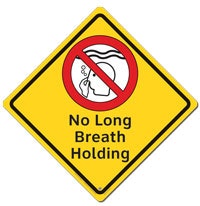The July deaths of two 21-year-old men in a Staten Island, N.Y., public pool brought increased attention to shallow water blackout - a largely unknown and potentially fatal condition that occurs when an insufficient amount of carbon dioxide is available to activate the body's natural impulse to breathe. Swimmers and free divers who practice prolonged underwater breath-holding are particularly at risk.
By hyperventilating prior to submersion, an individual blows off an excessive amount of carbon dioxide and can, in the process, surrender his or her breathing reflex. When the oxygen level in the blood runs low enough, that person loses consciousness. He or she never actually feels the need to breathe underwater and sometimes even experiences euphoria. A series of events - including water inhalation, possible convulsions and ultimately cardiac arrest and death - follows. Unlike regular drowning, which can take six to eight minutes before brain damage and death occur, SWB can kill within two and a half minutes, experts say.
Virginia Graeme Baker Pool and Spa Safety Act to stop suction entrapment deaths. We've never had more than a dozen people die from suction entrapment. I don't want to say we don't need that law. But we don't have any law saying you can't hold your breath underwater in pools. It's a much bigger problem."
How much bigger? Because medical examiners typically state the cause of death as "drowning" - simply based on the fact that water is in the victim's lungs - no one really knows. Official statistics on shallow water blackout fatalities don't exist, but observers have nevertheless speculated.
Neal Pollock, research director of the nonprofit health and safety organization Divers Alert Network recently told California's Laguna Beach Independent that there have been an average of 44 breath-holding fatalities each year since 2004. Of those, he estimates approximately half are the result of shallow water blackout. "It's very unreported, because there isn't a lot of physical evidence left," Pollock told reporter Ted Reckas shortly after free diver Andrew Brislen died in May from what is now believed to be shallow water blackout near Laguna Beach's Picnic Beach.
"If the Divers Alert Network sees that many shallow water blackouts a year, the number of shallow water blackouts in pools should be much higher," Griffiths predicts. He says awareness of SWB has been around since the 1950s, when it was a U.S. Navy term used to describe a temporary condition deep-sea divers experienced shortly before surfacing. "It wasn't until the '90s that we figured out shallow water blackout was killing people in swimming pools."
People like Sam Goodenough, a 16-year-old New Zealander, who died Jan. 4 after he was pulled from the bottom of a pool a week earlier while competing with friends to see who could hold their breath underwater the longest. The boy blacked out and failed to surface, according to reports; his friends thought he was just playing around.
In March, a 43-year-old father of three died while practicing breath-holding in a Maine YMCA swimming pool, and in July, off-duty lifeguard Jonathan Proce and his friend Bohdan Vitenko suffered cardiac arrest at the bottom of Staten Island's Lyons Pool while performing breath-holding exercises in preparation for military duty. Vitenko died in the pool; Proce died five days later. Both men were regulars at the pool, reportedly participating in grueling workout routines that included underwater sit-ups.
"They would just be typical drowning victims if the pool staff hadn't known them and hadn't known what they were doing," Griffiths says. "There are many more shallow water blackout victims that go unnoticed because the lifeguards and the staff didn't watch them holding their breath or didn't know their history of training underwater."
The April death of 25-year-old free diver Whitner Milner was ruled a drowning, but his family and friends now realize he succumbed to SWB while practicing holding his breath in a residential pool after dark. He was found at the bottom, one arm across his abdomen and his other arm resting under his chin - a typical posture for underwater breath holders. In fact, many underwater breath-holders simply sit down in a corner of a pool with a weight belt on their lap to keep them from surfacing.
"I had never heard of shallow water blackout," admits Rhonda Milner, Whitner's mother and a retired radiologist who recently created the Norcross, Ga.-based nonprofit education and awareness organization Shallow Water Blackout Prevention. "I'm a physician, and everyone in my family is a certified scuba diver, and none of us had heard of it."
Since launching Shallow Water Blackout Prevention in June, she has received e-mails and phone calls from relatives of other victims on an almost daily basis, and more reported cases of suspected SWB are beginning to surface. Milner ultimately hopes to create an online memorial for victims on the organization's website. "It's a huge part of healing when some significance can come out of your tragedy," she says. "For me, this was a natural response. How could I not respond?"
Milner plans to join Griffiths at several upcoming industry events to tell her son's story and advocate for greater education and legislation. "In the past, all of these shallow water blackout victims kind of just faded away," Griffiths says. "But now we have a mother who lost her son. We need her, because it really puts a face on the tragedy. Most people don't know this is even a problem. First and foremost, before we can get regulation, we need education."
That begins with lifeguards. For reasons Griffiths can't explain, the American Red Cross - which trains the majority of lifeguards in the United States - did not include SWB in its manuals between 1995 and 2007. Furthermore, he suggests lifeguards are intimidated by underwater breath-holders, who often are more physically fit or better swimmers than the guards themselves. "They think, 'Who am I to tell them not to do this?" Griffiths says. "There's your recipe for disaster."
In most all SWB cases, victims hold their breath "under the mistaken assumption that they can increase their own cardiovascular capacity," Kevin Trapani, president and chief executive officer of The Redwoods Group, a North Carolina-based insurance provider to YMCAs, says in a video message on the company's website. "It doesn't work. We cannot allow people to practice breath-hold training at our YMCAs, at our JCCs, at our camps, in our pools, in our lakes, anywhere. Ever."
Trapani added that SWB education is a never-ending process: "Part of our challenge is that we have very high turnover among our aquatics staff."
As The Redwoods Group states in some of its SWB literature, "A lifeguard's role is to ensure the safety of swimmers - that includes enforcing pool safety protocols. All lifeguards should be thoroughly knowledgeable regarding the dangers of shallow water blackout. They should understand that they have the power and responsibility to stop any hypoxic activity that is being done in their pools. Management should clearly communicate their support of the lifeguards in the enforcement of this policy."
Griffiths and Milner are pushing for mandatory signage at all aquatic facilities prohibiting underwater training and long breath-holding. At least one company, Milford, Pa.-based Clarion Safety Systems LLC, has developed copyrighted signs targeting SWB, including a diamond-shaped yellow sign that shows a person plugging his nose surrounded by a red circle with a line through it. Below, the copy reads: "No Long Breath Holding." A similar sign includes additional verbiage, explaining why underwater breath-holding is dangerous. Signs can be customized in several different languages.
 SWBsign.jpg
SWBsign.jpg
Swimmers who go multiple pool lengths without taking a breath - "I promise you, somewhere that's happening right now," Trapani says in his video message - also are at great risk. In Griffiths' research, every swimmer who died while attempting to swim laps underwater died while swimming the third pool length. Breath-holding swimmers who take long, exaggerated strokes before eventually just stopping altogether may be exhibiting potentially deadly SWB symptoms.
That said, Griffiths contends that the majority of swimming coaches still encourage hypoxic training with low-frequency breathing patterns. In 2009, an Indiana high school swim coach passed out while swimming beneath the surface and had to be rescued by a freshman member of the team. He reportedly had challenged his swimmers to see who could swim farther than him without coming up for air. On his third lap, the coach twisted suddenly and floated to the surface, yet his head remained submerged. "Not only did that coach almost kill himself, he almost showed 50 other people how to kill themselves," Griffiths says. "If all facilities were signed properly, there is a good chance that people wouldn't do it. And if they did do it, the media would say there was a sign stating they shouldn't, but they did it anyway. That would help get the word out about the dangers of shallow water blackout."




































